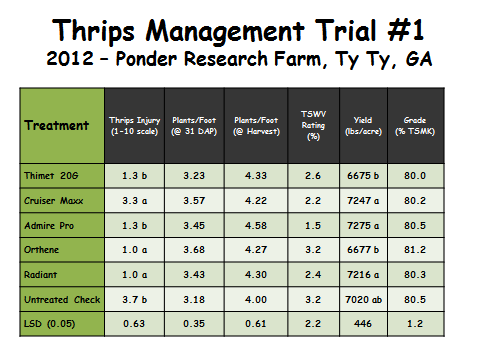As local farmers place orders for peanut seed, many have asked for more information about using CruiserMaxx Peanuts seed treatment instead of Thimet. Dr. John Beasley, Extension Peanut Agronomist from University of Georgia provided some very timely information.
Dr. John Beasley: “What CruiserMaxx Peanuts will offer is convenience to the producer. If a producer uses CruiserMaxx Peanut treated seed they will not have to use an in-furrow insecticide at planting. It doesn’t matter if a producer uses CruiserMaxx Peanuts, Thimet insecticide in-furrow, or Orthene insecticide on the seed or as a topical application, as long as they use something to control thrips.
In 2012 I conducted two trials at the University of Georgia’s Ponder Research Farm near Ty Ty in Tift County. The “thrips injury ratings” were taken at 30 DAP and are based on a 1-10 scale with a “1” being a very healthy plant with minimal, if any, discernible thrips feeding or injury. A “10” would be a dead plant. A rating of a “6” would be significant thrips injury.
You will notice in trial #1 that the level of thrips injury was relatively low. Although we planted these two trials early (late April) in order to trigger maximum thrips injury, we hypothesize that the much warmer than normal winter and early spring of 2012 resulted in thrips emerging earlier than normal. As a comparison, in thrips trials we conducted in 2010 and 2011, the untreated check (UTC) in those years had thrips injury ratings of 6.0 to 6.5 and the Thimet treatments in those years had ratings of approximately 2.5. Therefore, the thrips injury ratings in 2012 were considerably less than the previous two years. As cold as the late winter and early spring of 2013 has been we could expect thrips emergence to be delayed and possibly heavy for late April planted peanut fields.
Based on the data from these two trials (which were planted beside each other at the Ponder Farm), the CruiserMaxx Peanuts treatment had thrips injury similar to the untreated check. However, when you look at yield and grade at the end of the season, CruiserMaxx Peanuts was at or near the top. What we don’t know at this point is how CruiserMaxx Peanuts will perform in regards to thrips control in a very heavy thrips injury year compared to the other more widely used treatments of Thimet and Orthene. We may get a chance to see these results this year.”
Mace Bauer: My concern after working with area farmers is that they have little tolerance for thrips injury even when it is only cosmetic in nature. If thrips injury of CruiserMaxx Peanuts treated seed is similar to no treatment as observed in this research, I expect many calls about crinkled peanut leaves. If this occurs, I expect many of you will ask for a recommendation for foliar treatments. I suggest farmers treat this new seed technology with caution as they would any new technology. Before making wholesale changes of an important input, try this on a portion of your farm as you would any new seed, fertilizer, or other input. One question that arises is; If yields are comparable without any thrips treatment, why use one? Dr. Beasley has reiterated at many county meetings that Tomato Spotted Wilt Virus pressure has been very low the last several year. In a year with severe pressure the yield losses without thrips control may be large.
Check back later this week and we will discuss Admire Pro in Thrips Management Trial #2 as another alternative for thrips control. It looks pretty promising as you can see in the chart above.

